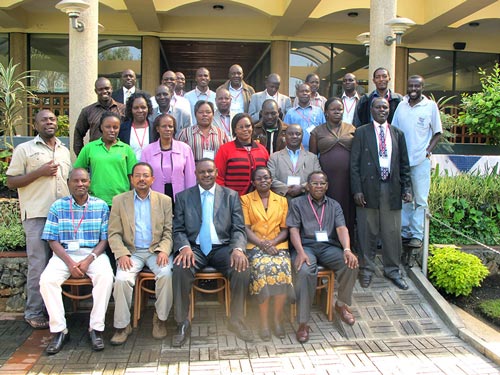 The metal silo technology promoted by CIMMYT for maize storage has been hailed in Kenya as the ultimate solution to high maize postharvest losses caused by the maize weevil (Sitophilus zeamais) and large grain borer (Prostephanus truncatus), two major destructive insects of stored maize causing 30% losses and more than 80% damage to stored maize in Kenya and other countries in sub-Saharan Africa. The real losses are even bigger: when considering their environmental impact, the subsequent losses in nutritional value, industrial input, market opportunities, and the possible adverse effects on health of populations consuming poor-quality products, the need for interventions becomes even more apparent and pressing. “Addressing waste across the entire food chain must therefore be a critical pillar of future national food strategies,” said Ngari Nyaga, Crop Post Harvest Division head at the Kenyan Ministry of Agriculture, during the official opening of a national Stakeholders Workshop on Effective Grain Storage for Sustainable Livelihoods of African Farmers Project (EGSP-II) held in Nakuru, Kenya, on 28 June 2013.
The metal silo technology promoted by CIMMYT for maize storage has been hailed in Kenya as the ultimate solution to high maize postharvest losses caused by the maize weevil (Sitophilus zeamais) and large grain borer (Prostephanus truncatus), two major destructive insects of stored maize causing 30% losses and more than 80% damage to stored maize in Kenya and other countries in sub-Saharan Africa. The real losses are even bigger: when considering their environmental impact, the subsequent losses in nutritional value, industrial input, market opportunities, and the possible adverse effects on health of populations consuming poor-quality products, the need for interventions becomes even more apparent and pressing. “Addressing waste across the entire food chain must therefore be a critical pillar of future national food strategies,” said Ngari Nyaga, Crop Post Harvest Division head at the Kenyan Ministry of Agriculture, during the official opening of a national Stakeholders Workshop on Effective Grain Storage for Sustainable Livelihoods of African Farmers Project (EGSP-II) held in Nakuru, Kenya, on 28 June 2013.
Tadele Tefera, CIMMYT entomologist and EGSP-II coordinator, outlined the workshop objectives: provide a forum to exchange ideas, information, and research outputs on EGSP-II among stakeholders in Kenya; raise awareness on postharvest losses and dissemination of effective grain storage technologies among stakeholders; consult stakeholders on policy environment and market issues for the purpose of refining, updating, and implementing EGSP-II; engage in policy dialogue on matters related to storage; find means of enhancing the technology adoption; and acquaint key stakeholders in the country with the technology and how they could enhance its adoption among the farmers they are supporting through their activities.
With the annual average production of about 33 million 90-kilogram bags, postharvest losses of about 20% translate into 540 million kilograms. “The metal silo technology being promoted by CIMMYT is a timely and critical element in the quest to promote food security,” stated Nyaga, pointing out that about two million Kenyans are considered food insecure. The technology will “lower postharvest losses, assist farmers to save on dusting labor, have healthy and tradable grains, and allow the farmers to wait for better prices instead of selling immediately after harvest for fear of losing their grains to weevils, larger grain borer, and poor storage.” The technology will also help to address an issue recently reported in a Ministry of Agriculture survey: the incorrect use of pesticides. According to Nyaga, metal silos will “lead to zero usage of storage pesticides, hence result in better health and stoppage of illegal use of restricted pesticides by farmers.”
As other forms of storage – traditional granaries and sisal and gunny bags – have proven ineffective, and chemical control unsuccessful (only half of Kenyan maize farmers use storage pesticides), Nyaga welcomed the decision of Kenya, Uganda, Tanzania, Rwanda, and Burundi to work together to develop technologies and policies to reduce crop postharvest losses in the region.
The workshop gave stakeholders a chance to update themselves on the project, appreciate the magnitude of the postharvest losses and the effectiveness of alternative postharvest technologies being used, and better understand the economics of postharvest management. It also provided the latest news from onstation trials on metal silo technology and super grain bags.
Tefera thanked the Swiss Agency for Development and Cooperation for funding EGSP II, a project aiming to reduce postharvest losses, enhance food security, and improve incomes of resource-poor farmers in Kenya.
 Innovations
Innovations